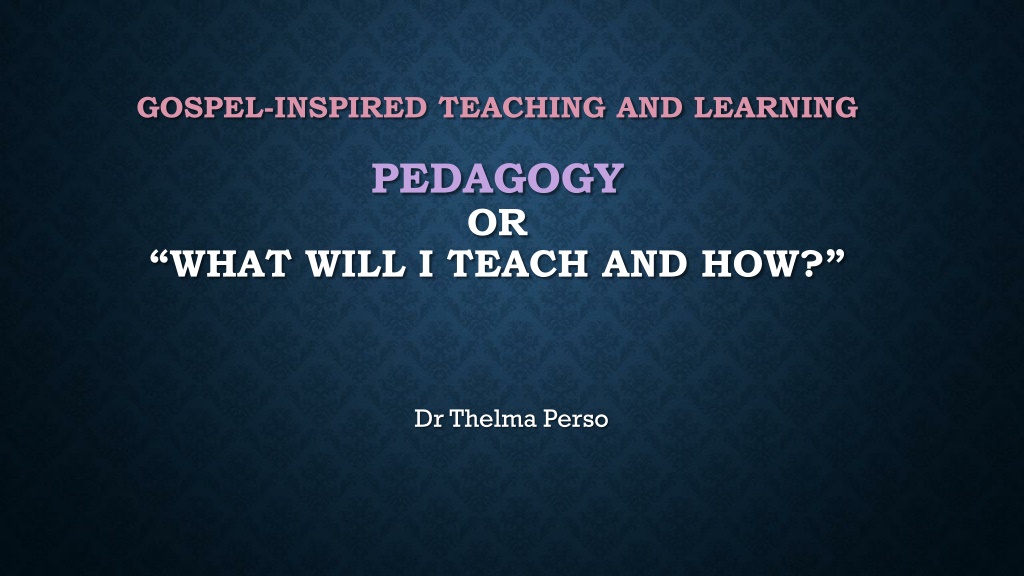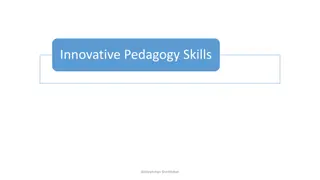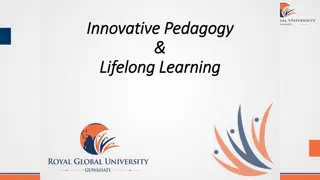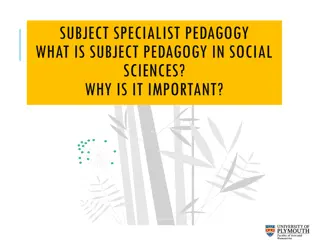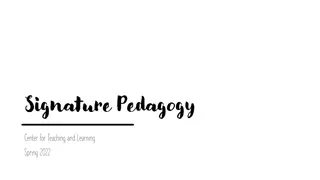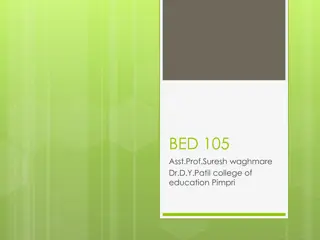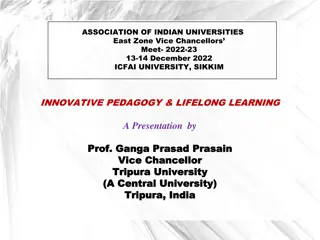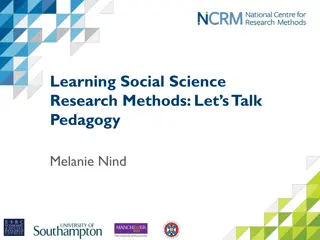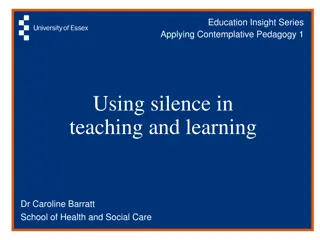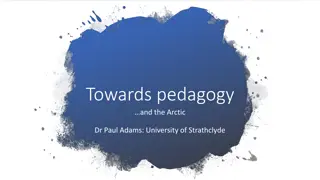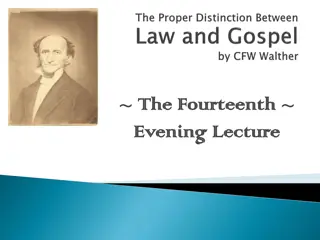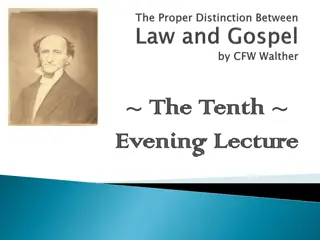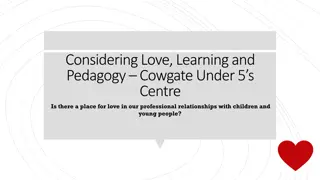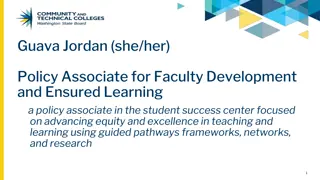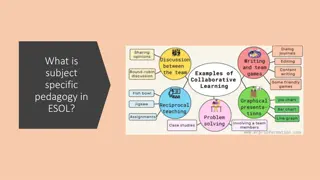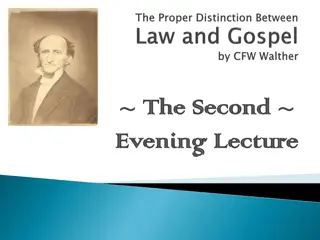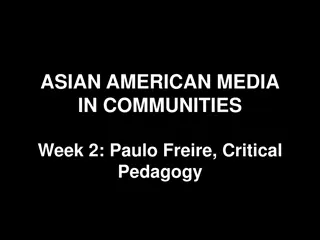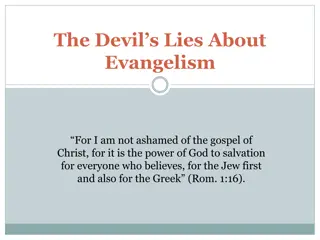Insights into Gospel-Inspired Teaching and Learning Pedagogy with Dr. Thelma Perso
Explore the profound teachings and learning strategies infused with a Gospel-inspired perspective by Dr. Thelma Perso. Delve into the significance of teaching from a Christian worldview and understanding the core elements of curriculum design in an educational setting. Discover the transformative outcomes of a Gospel-inspired schooling approach, inviting students to know Jesus, experience His love, and address injustices in the world. Uncover the essence of designing and enacting curriculum pedagogy akin to leading an orchestra, where every element plays a crucial role in shaping impactful learning experiences.
Download Presentation

Please find below an Image/Link to download the presentation.
The content on the website is provided AS IS for your information and personal use only. It may not be sold, licensed, or shared on other websites without obtaining consent from the author. Download presentation by click this link. If you encounter any issues during the download, it is possible that the publisher has removed the file from their server.
E N D
Presentation Transcript
GOSPEL-INSPIRED TEACHING AND LEARNING PEDAGOGY OR WHAT WILL I TEACH AND HOW? Dr Thelma Perso
My Story. What does it mean to teach from a Christian worldview ? Didn t I do that for 20 years? Gospel-Inspired teaching and learning PSA: SCEA-Proficient teacher standards
LET US BE OPEN.. To what God might be saying to each of us today Some might be doing it all he will reaffirm us Others might be challenged by his gracious Holy Spirt to do things differently let s not close the door on him The intentions he has for us are all good. His desires and aspirations for us are enormous, full of potential for unimagined benefit to us and our students. His thoughts towards us are thoughts of peace and blessing let us not holdback! Consider who God made us to be do we know?
CURRICULUM Curriculum is all the planned learning that occurs in a school Students can also learn things that we don t plan or desire for them to learn things that aren t planned Examples?
3 STUDENT OUTCOMES OF GOSPEL- INSPIRED SCHOOLING Outcome 1: Students know the invitation extended by Jesus to all people to follow him and experience the abundant life that he promises (John 10:10) Outcome 2: Students encounter Jesus and his love through the school environment Outcome 3: Students identify injustice in our world and have skills and confidence to act in addressing it
Intended (desired) learning (Mandated Curriculum & School-desired outcomes) What goes here? Experienced/Learned curriculum
DESIGNED AND ENACTED CURRICULUM PEDAGOGY
LEADING AN ORCHESTRA. What instruments play and when How loud, how soft How fast, how slow More of this instrument and less of that And then .. Continual reflection on whether it is working or not having the desired effect or not maintaining engagement? Resulting in a pleasing experience for the audience or not
PEDAGOGY IS A HOME Pedagogy is a home where students and teachers live for a while (David Smith, 2018,p.12) In groups/pairs, discuss all the things you learn from in your home environment while you are growing up Let s share!
SMITHS METAPHOR Children learn through every aspect of the home environment in which they live, including interactions with parents and siblings (including their words, tone, body language, stance, pace etc) soft furnishings and colours objects and artwork texts and resources nature of relationships, and noise, music, technology, devices, light
GOOD TEACHERS Good teachers craft the delivery of what they want their students to learn. They carefully construct an environment that will maximise learning for all their students. This may mean using a variety of teaching styles in every lesson, and changing the way they use the environment and select resources all of which can serve to maximise learning. Generally, the effectiveness or not of a lesson will depend on the skill of the teacher in orchestrating the interplay between what is chosen and how it is delivered, to initially engage students and then to ensure they are learning what is desired. Will this depend on the resources available? ..is it possible without a range of resources? Will primary teachers in their classrooms have an advantage?
THE SAME IN TEACHING. Pedagogy is a complex process and requires skill and continuous reflection by the teacher on the effectiveness of what they are doing Teachers are constantly reflecting on their impact on students Smith s description makes the parallel by indirectly stating that students are immersed in an environment created by their teacher having the deliberate intention that they learn from everything that their teacher has immersed them in. This indicates a belief that everything that is occurring within the bubble that is the learning environment, is teaching our students. They are learning from everything that is going on both the good and the not so good.
SMITHS ANALOGY If pedagogy is a home, then we as teachers control what we want students to learn from every aspect of the class environment The analogy of a home aptly describes what we call pedagogy since it is the interconnection of the delivery of the planned lesson (which itself is subject to change during the delivery) with the physical and social environment that will either result in students learning, or not.
A HOUSE OR A HOME? A house is somewhere that we live a physical structure what makes it a home? In learning, the parallel might be the difference between a lecture via zoom and a classroom experience with teacher and class interaction, in which we are invited to participate. A home is generally comprised of warm, loving relationships a nurturing space.
A home is a nurturing space where children and young people feel safe, accepted, included, are cared for, listened to, and where they can work as part of a community, in family. Each participant wants the best for everyone else. When a classroom feels like a home it is because a teacher is crafting a nurturing space as part of their pedagogical practice. Is our classroom a house or a home? (remember, this is a lot more about how you make students feel than the physical environment)
WHAT CAN WE DO TO MAKE OUR PEDAGOGY A HOME ? In designing and delivering a lesson, what do we need to consider so that the experience of our students will be like being in a home? (a nurturing environment) Self reflection: do we want our classroom to be a nurturing space or not? Do we want our students to encounter Jesus in our lessons?
HOW DO CHRISTIAN TEACHERS DO THAT? THE PEDAGOGICAL PRACTICES OF A CHRISTIAN TEACHER opportunities for students to relate and connect with each other and with their teacher, to really know each other and care for the wellbeing of their class community; inclusion acceptance, welcoming - students feeling included and valued for who they are, not feeling alienated or other , but that they belong; having agency and a say in the interactions that occur; students are active participants in the interactions and learn from each other as well as from their teacher; students work together to reason and consider how their learning can benefit society as a whole and how they might serve each other and the broader community.
A teacher is not effective by virtue of their title or role description. Their effectiveness depends entirely on their ability to choose, craft and implement the pedagogical strategies that serve to bring about the desired learning in their students. As David Smith states98: there is no quick recipe for Christian pedagogy, just a long process, worked out with fear and trembling .It is born of prayer, of study, of listening to students, of the acquired discipline of attentiveness to what is happening in class, of the humility that allows us to hear from others that our best efforts are not quite doing what we think they are . Smith, D. (2018, p.136)
CAIRNEY 2018, P.31 Our pedagogical practices will lead to the creation of a classroom life that has the potential to speak to our students about what is important in the world of the classroom and consequently, what matters in the world.
STEPS IN DESIGNING A LESSON Choose the intended learning Choose the teaching focus Choose a research-informed pedagogical strategy (e.g. HITS, 4 Productive Pedagogies, Marzano s 9 Essential Instructional Strategies) Design the physical and social environment Design a nurturing space Address inequities and empower changemakers
A taster only of what is in Gospel-Inspired Teaching and Learning Reflect on: do I agree? Don t I agree? Why not? What caveats do I have? Will I walk out of here and think This doesn t apply to me ..because? A key verse from the scriptures (1 Peter 3:8-12; Message Bible): be agreeable, be sympathetic, be loving, be compassionate, be humble. That goes for all of you, no exceptions. No retaliation. No sharp-tongued sarcasm. Instead, bless that s your job, to bless. You ll be a blessing and also get a blessing.
